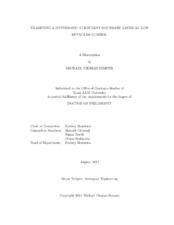| dc.description.abstract | The purpose of the current study was to answer several questions related to hypersonic, low Reynolds number, turbulent boundary layers, of which available data related to turbulence quantities is scarce. To that end, a unique research facility was created, instrumentation was developed to acquire data in the challenging low Reynolds number (low density) domain, and meaningful data was collected and analyzed. The low Reynolds number nature of the boundary layer (Re_theta = 3700) allows for tangible DNS computations/validations using the current geometry and conditions. The boundary layer examined in this experiment resembled other, higher Reynolds number boundary layers, but also exhibited its own unique characteristics.
The Van Driest equivalent velocity scaling method was found to perform well, and the log layer of the law of the wall plot matched expected theory. Noticeably absent from the data was an overlap region between the two layers, which suggests a different profile for the velocity profiles at these low Reynolds number, hypersonic conditions. The low density effects near the wall may be having an effect on the turbulence that modifies this region in a manner not currently anticipated. The Crocco-Busemann relation was found to provide satisfactory results under its general assumptions.
When compared to available data, the Morkovin scaled velocity fluctuations fell almost an order of magnitude short. Currently, it is not known if this deficit is due to inadequacies with the Strong Reynolds Analogy, or the Morkovin scaling parameters.
The trips seem to promote uniformity across the span of the model, and the data seems to generally be in agreement across the spanwise stations. However, additional information is needed to determine if two-dimensional simulations are sufficient for these boundary layers.
When the turbulent boundary layer power spectra is analyzed, the result is found to follow the traditional power law. This result verifies that even at low Reynolds numbers, the length scales still follow the behavior described by Kolmogorov.
Moving downstream of the trips, the peak RMS disturbance value grows in amplitude until it reaches a critical value. After this point, the peak begins to decrease in amplitude, but the affected region spreads throughout the boundary layer. Once the influenced region covers a significant portion of the boundary layer, transition occurs. | en |


